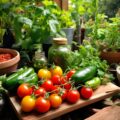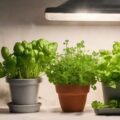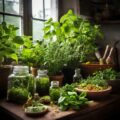Getting Started with Your First Vegetable Garden
Embarking on your first vegetable gardening journey can be an exciting and rewarding experience. Not only does it provide you with fresh, nutritious produce right at your doorstep, but it also offers a wonderful opportunity to connect with nature and nurture your own little piece of the earth. For beginners, it’s best to start small and choose easy-to-grow vegetables that will boost your confidence and enthusiasm for gardening. In this article, we’ll explore some of the easiest vegetables for novice gardeners to cultivate, along with tips to help you succeed in your new green adventure.
Leafy Greens: The Perfect Starting Point
Leafy greens are among the most forgiving and fastest-growing vegetables, making them ideal for beginners. Here are a few options to consider:
- Lettuce: Quick-growing and versatile, lettuce can be harvested as early as 3-4 weeks after planting for baby greens.
- Spinach: Nutrient-dense and easy to grow, spinach thrives in cooler weather and can be planted in early spring or fall.
- Kale: This hardy vegetable is not only easy to grow but also packed with vitamins and antioxidants.
These leafy greens can be grown in small spaces, even in containers on a balcony or patio. They require minimal care and can be harvested continuously, providing a steady supply of fresh greens for your salads and smoothies.
Root Vegetables: Hidden Treasures in Your Garden
Root vegetables are another excellent choice for beginner gardeners. They’re relatively low-maintenance and offer a satisfying harvest. Consider these options:
- Radishes: One of the fastest-growing vegetables, radishes can be ready to harvest in as little as 3-4 weeks.
- Carrots: While they take a bit longer to mature, carrots are easy to grow and offer a delightful crunch to your meals.
- Beets: Both the roots and leaves of beets are edible, offering versatility in your cooking.
Root vegetables teach patience and the joy of discovery as you unearth your harvest. They also demonstrate the importance of soil quality and proper spacing for optimal growth.
Tomatoes: The Garden Favorite
No beginner’s vegetable garden would be complete without tomatoes. While they require a bit more care than leafy greens or root vegetables, the reward of plucking a ripe, juicy tomato from your own plant is unparalleled. Here are some tips for success with tomatoes:
- Choose determinate varieties for easier management
- Provide support with stakes or cages
- Water consistently and mulch to retain moisture
- Prune for better air circulation and disease prevention
Growing tomatoes can be a heartwarming experience, as you watch tiny seedlings transform into robust plants laden with fruit. It’s a journey that teaches patience, care, and the rewards of nurturing life.
Herbs: Aromatic and Versatile
Herbs are not only easy to grow but also add flavor and fragrance to your garden and kitchen. Some beginner-friendly herbs include:
- Basil: A must-have for Italian cuisine lovers
- Mint: Grows vigorously and is perfect for teas and cocktails
- Cilantro: Adds a fresh kick to Mexican and Asian dishes
- Parsley: Versatile and nutritious
Growing herbs can be a sensory delight, filling your garden with wonderful aromas and providing fresh flavors for your cooking. They also attract beneficial insects, contributing to a healthy garden ecosystem.
Cultivating More Than Just Vegetables
As you tend to your vegetable garden, you’ll find that you’re growing more than just plants. Gardening nurtures patience, resilience, and a deep appreciation for the natural world. It’s a practice that can reduce stress, improve mental health, and provide a sense of accomplishment.
Remember, gardening is a journey of learning and discovery. Don’t be discouraged by setbacks; every gardener, no matter how experienced, faces challenges. Embrace the process, learn from your experiences, and celebrate every small success.
As you harvest your first vegetables, take a moment to appreciate the miracle of growth and the connection you’ve fostered with the earth. Share your bounty with friends and family, spreading the joy and nourishment that comes from homegrown produce.
FAQ: Getting Started with Vegetable Gardening
1. How much space do I need to start a vegetable garden?
You can start a vegetable garden in any space you have available, even if it’s just a sunny windowsill or a small balcony. Container gardening is perfect for small spaces, while a 4×4 foot raised bed can provide a good starting point for those with more room.
2. When is the best time to start planting vegetables?
The best time to plant depends on your local climate and the vegetables you’re growing. Generally, cool-season crops like lettuce and peas can be planted in early spring, while warm-season crops like tomatoes and peppers should wait until after the last frost date in your area.
3. How often should I water my vegetable garden?
Watering frequency depends on your climate, soil type, and the vegetables you’re growing. As a general rule, most vegetables need about 1 inch of water per week, either from rainfall or irrigation. It’s better to water deeply and less frequently to encourage deep root growth.
4. Do I need to use fertilizers in my vegetable garden?
While not always necessary, fertilizers can help ensure your plants get all the nutrients they need. For beginners, starting with good quality, nutrient-rich soil is often sufficient. As you become more experienced, you can explore organic fertilizers and compost to enrich your soil.
5. How do I protect my vegetable garden from pests?
There are several eco-friendly ways to protect your garden from pests. These include companion planting, using physical barriers like row covers, practicing good garden hygiene, and encouraging beneficial insects. For specific pest problems, consult local gardening resources for targeted, organic solutions.









